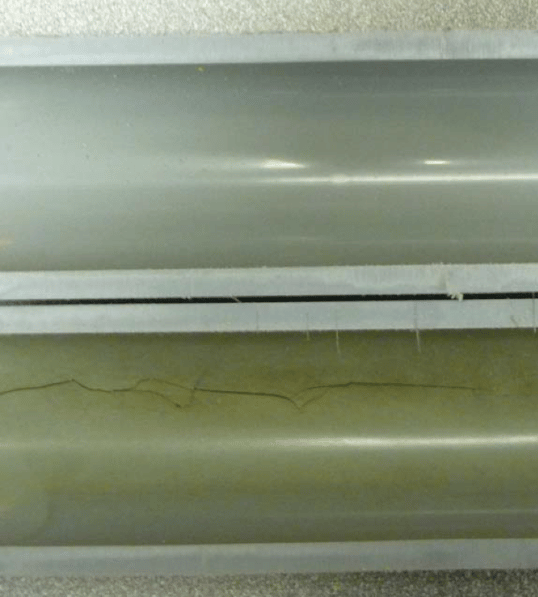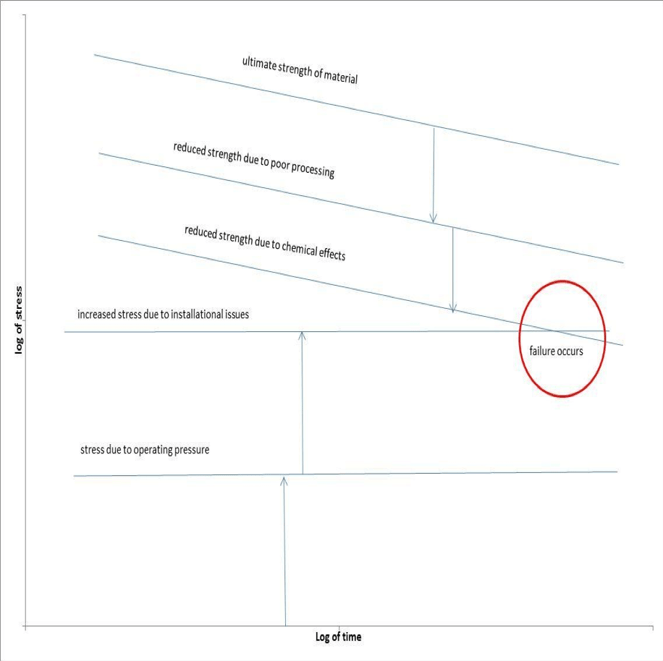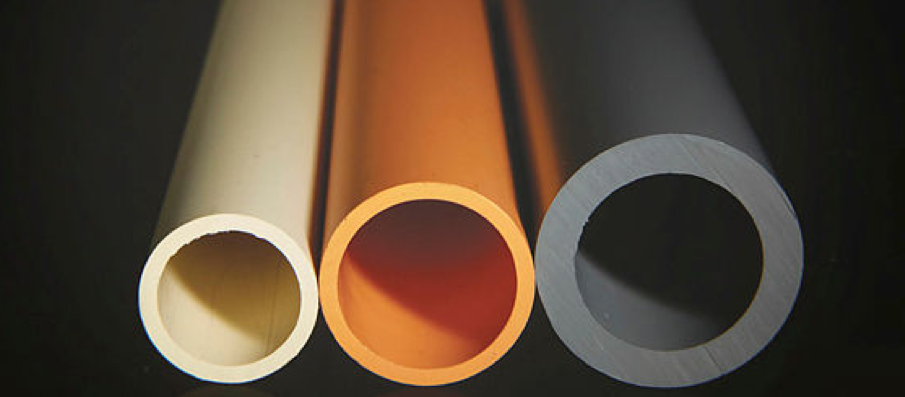How to Avoid Environmental Stress Cracking in Plastic Piping
Environmental stress cracking (ESC) is one of the leading causes of plastic pipe failure. It occurs when the piping material is simultaneously subjected to mechanical stress and certain types of chemicals.
ESC typically results when incompatible chemicals and external mechanical forces work together to overcome the piping material’s strength. ESC can be avoided by considering the chemicals and mechanical stresses that will affect a piping system’s performance and addressing those factors during system design and installation.

Understanding Why ESC Occurs
Amorphous polymers like CPVC get their strength from long chain-like molecules that are tangled together. CPVC will fail when enough chains break or become sufficiently disentangled that a breach develops in the solid polymer. This breakage and/or disentanglement can result from strong mechanical stresses, strong chemicals or a combination of moderate levels of both.
Most people conceptually understand the idea of a strong mechanical stress such as impact causing the pipe to break, or a strong solvent causing the pipe to soften or dissolve. ESC occurs when there is a moderate stress that by itself wouldn’t be enough to break the plastic combined with a moderate chemical that by itself wouldn’t be enough to dissolve the plastic. When there is a stress pulling on the molecules of the polymer and a chemical sitting on the surface that is capable of causing some weakening of the polymer, a crack can develop on the surface of the plastic. With the stress continuing to pull on the molecules and the chemical moving in to weaken the molecules in the tip of the crack, the crack can continue to propagate until it breaches the pipe wall.
How Pipe Quality Affects ESC Resistance
The quality of part manufacturing can affect its resistance to chemicals and environmental stress cracking. The melt mixing that occurs in the extrusion or injection molding process creates the molecular entanglements as the parts are formed.
Adequate mixing and entanglement may not be possible if processing conditions are poor, and certain vulnerable areas may not achieve adequate entanglement. Other types of defects such as voids, inclusions or score lines can create areas of localized weakness or elevated stress. When molecules are not adequately entangled in the first place, they are easier to disentangle by mechanical or chemical effects.
How Mechanical Stress Impacts Plastic Piping
The mechanical stresses working to disentangle the polymer molecules can come from a variety of sources. Besides operating stress caused by pressure in the pipe, stresses may result from installation issues such as excessively tight pipe hangers, improper connections and joining, inadequate support, excessive bending, etc.
The illustration below shows how failure can occur when combined stresses exceed the strength of a piping material that has already been weakened by quality issues and the effects of chemicals.

Conversely, if mechanical stresses are low and material processing has been sufficient to achieve good molecular entanglement, the plastic piping material may perform for years without problems – even though it comes into direct contact with a chemical classified as “incompatible.”
Following the manufacturer’s installation instructions can help minimize mechanical stress. Issues such as overtight clamping, improper hanger spacing and failure to account for thermal expansion can result in elevated stress levels that allow cracking in a poorly installed system.
Other Chemical Concerns
Often only the major components of the process fluid are taken into consideration when a piping material is specified. It’s also important to consider the low-level chemical components contained in a facility’s process fluid.
While CPVC may be able to handle 99 percent of these chemicals, the other 1 percent may cause the pipe to stress crack. Chemicals such as solvents or nonionic surfactants may contribute to ESC of the piping even when present at levels lower than one percent. Make sure all the constituents of the process fluid are identified and ask questions regarding CPVC’s resistance to these chemicals. The Corzan® CPVC Chemical Resistance Chart shows the compatibility of Corzan CPVC with over 400 chemicals.
External chemical exposure should also be examined. Will ancillary construction products such as firestopping materials or thread sealants be used? The piping system’s resistance to these and other potential sources of external chemical exposure must be determined. Will there be ancillary construction products such as firestopping materials or thread sealants used? The FBC™ System Compatible Program lists a variety of compatible and incompatible construction products by brand name.
Piping to Minimize ESC
It is nearly impossible to predict all of the mechanical variables and the different chemicals that will end up in the interior or exterior of a piping system. The designer and installer, therefore, must take steps to control the factors that can help prevent ESC.
- Specify a compound with a reputation for consistently exceeding minimum strength standards.
- Select pipe and fittings sourced from a manufacturer with a reputation for production quality excellence.
- Consult the manufacturer’s installation instructions regarding the best way to design and install the piping system.
- Determine the material’s resistance to all chemicals that will be flowing through the pipe or may come in contact with the exterior of the piping.
- Choose ancillary construction products that have demonstrated little or no effect on the piping material.
With over 60 years of application success, Corzan CPVC offers significantly higher pressure ratings, tensile strength and impact strength than the minimum requirements of various applicable standards. And, Corzan partner manufacturers have a history of providing consistent, high-quality products to meet specific application needs.
Contact a Corzan engineering expert or a partner manufacturer for engineering guidelines or to schedule a free process suitability review and technical assessment.
Details for this blog were taken in part from the following:
https://www.corzan.com/en-us/corzan-cpvc-chemical-resistance-chart
https://www.corzanplumbing.com/fbc-system-compatibility/


